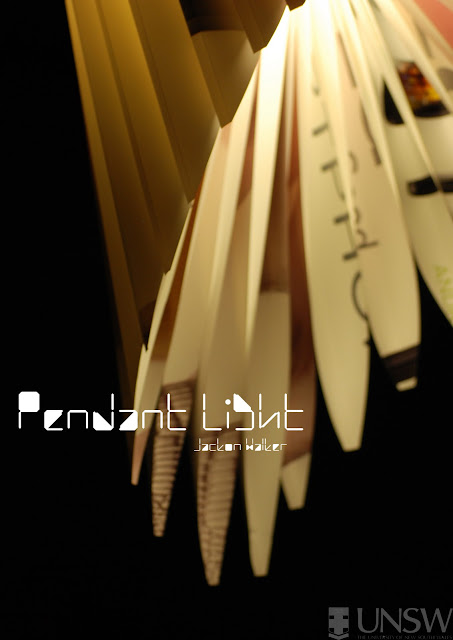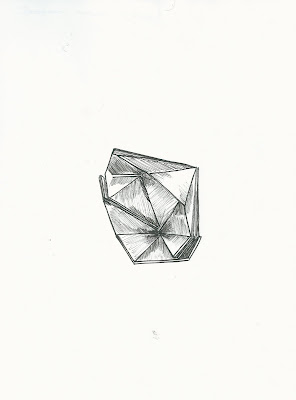Wednesday 19 October 2011
Tuesday 18 October 2011
Utilizing Utility: Rationale
This lamp prototype is made out of upcycled synthetic paper advertising posters, metal spacers and steel wire. Through staying true to the limits of the material, symmetry and repeating patterns I was able to create my lamp using structured folding techniques and straight lines protruding from a circular base to still create the dynamic form of this light It displays a contrast between a rigid and structured exterior to an organically shaped interior. The layers that form the light shade are constructed from the same base shape and the length is then altered- this in turn has produced a cutting diagram that is materially efficient as each piece can be tessellated against the next on a flat sheet.
The shape of this pendant lamp is similar to that of a traditional lamp, however contrasts to its structural design. it has been successfully executed in a way that it displays and also hides varying facets of the light from different positions in a room. However, still attains a warm distilled glow from all angles of perspective.
Thursday 15 September 2011
Peer Comments
Camilla Kordek- Appearance Model ( Hidden Vines Garden Fork)
Mitchell Harris- Product Storyboard (Incognito Grater)
Cherrie Fillisia- Project 1 (Mortar and Pestle)
Ghina Ali- Luxury at your hands. (Letter Opener)
Dennis Lee- Vigo Cheese (Cheese Grater)
Bill Moggridge. What is Design?
Mitchell Harris- Product Storyboard (Incognito Grater)
Cherrie Fillisia- Project 1 (Mortar and Pestle)
Ghina Ali- Luxury at your hands. (Letter Opener)
Dennis Lee- Vigo Cheese (Cheese Grater)
Bill Moggridge. What is Design?
In the latest video I watched, Bill Moggridge explores the definition of design. He defines design as anything altered by man, and thus alludes to how broad design really is. There is no one category of design, but rather, it design itself branches out to reach the fashion industry, interior shapes and even engineering. From architecture, to industrial design, to interior design, Moggridge really covers many interesting aspects, focusing on design principals in this 55 minute video.
First Moggridge introduces us to both good and bad design. There is a segment where he discusses kitchen tools, and how they are categorised as “smart design”. This is because the kitchen utensil is easy to use, even for older people, people with arthritic hands. He draws attention to how a good design to the disabled is also good design to others. The example shown of bad design was the mention of the i-mode service. This service is used for purchasing soft drinks with mobile phones, and whilst some may marvel at the ingenuity of it, the designers didn’t cater for their target market, and thus, didn’t adhere to their needs. There were several issues with it, some of which included the long processing time and the confusing nature of it. Judging from a designers perspective, there was insufficient prototyping done before this was released, and there may have been miscommunications during the design process too.
This leads Moggridge to discuss the design process and its concepts. There are two main concerns. The first being understanding the consumer, and the second being prototyping. To understand people, there are three categories: people (desirability), business (viability) and technology (feasibility). To fully understand a consumer, all three of these branches must be put forward for thought. Moddridge concludes his explanation of the design process with an overview of the four things we must do and that is; to assess the flow of analysis, observe, ask and to experiment. The other half of the design refers to prototyping. There are three stages to prototyping; inspire, evolve and to validate. The constantly evolving technology in today’s world allows for easy simulations of designs, showcased on computer in its 3D form before even needing to construct a physical model. However, it is important that a physical model is made at some stage to examine all areas and to make adjustments.
Bill Moggridge also covers three expanding contexts relating to design. This would be the Personal, Social and Environmental aspects, each a crucial part of any designers mentality. Design is expanding towards the well being of people and their health, hence this heavily concentration on living more sustainably. Personal design concentrates on the consumer themselves. Social refers to the design for impact, to change something for improvement. Environmental looks at how the materials the object is made up of affects our world.
This video was very entertaining to watch and I loved hearing the design process being broken down into categories. It really helped me to understand the whole notion of design, as opposed to what a designer does.
Tuesday 13 September 2011
Monday 12 September 2011
Monday 22 August 2011
The Story of Stuff.
The story of stuff project is one of those videos that accelerates and popularises an idea that is starting to spread through society and I think that it should be commended. The danger with videos like this one is that they attract criticism and cynicism from a variety of sources for their up-beat positive sections and their doom and gloom negative sections equally. I think that free range studios and the story of stuff project have done an excellent job of getting the balance right. The use of animation is clever because it allows the central message to be delivered without causing seeming to piggy-back off disturbing images the way that some humanitarian aid videos do.
In terms of the video content I couldn’t agree more. I believe that there should be not only take back laws, but also a register of the longevity or otherwise that could be generated by an independent body that administers the laws. This way consumers would be able to see how many of product type x that the company manufactured the year before had been returned to the company for disposal and compare that to other manufacturers so that they could make informed decisions about what is and what isn’t going to be thrown away.
In terms of computers, modularity is the key. I believe that companies that ship products with non-replaceable batteries are a key culprit here. Another is non-standardized plugs, chargers, memory card slots hard drive sizes etc. I believe strongly in voting with ones feet in this department.
Tuesday 16 August 2011
My Design Career
The design industry is a dynamic and vibrant community of creative minds that want to try and make the world a better place. This is achieved through the systems, products, architectural environments that encourage creative thinking and inspiration to people who come in contact with them.
I have always wanted to have the ability to be apart of a person’s everyday life by changing how they do things and interact with their surrounding environment.
With our world changing as much as it is, there is a greater need for efficient and effective design to make the impact of the human race as positive as possible.
I originally entered into the Industrial Design program at UNSW as a way to get into University. After completing my HSC I wanted to go into Interior Design, either at UNSW or UTS, but with my ATAR being lower than desired I accepted my offer at UNSW in Industrial design.
Before starting this program I saw it simply as a stepping-stone into Interior Design. But now that I have started, I see this course more and more as a career that I could pursue.
After completing Fundamental in semester 1 I saw the creative process, rather than the design process, as an avenue that I would be more interested in. Focusing more on the ‘art pieces’ in design rather than the mass produced and ‘consumer’ based products. I accept that in order to get to the level of creating ‘one off pieces’ understanding the industry and the processes behind it is important
Like many other young Australian design students, Marc Newson has achieved a level of recognition that is an ambition for many. Coming from an average Australian family living in Newcastle seeing his transformation from an everyday person to a household name is a great achievement.
I think the future of the design profession will become more and more important as new ways of completing everyday tasks is needed. With the environment and cultural diversity of the planet become our main focus designers will be required to make broader and a diverse range of products to cater for larger number of people.
Monday 8 August 2011
Monday 1 August 2011
Thursday 28 July 2011
Human Centered Design.
To think about technology these days, it is notable that the products that we interact with on a day-to-day basis do not just simply perform the base function in which we purchased them to do. In fact, there is a sense of gratification in how thoughtful and personable some products can be to human emotions. Ted Kelly discusses this emerging trend in human-centered design.
Design approach to technology has transformed from functional gadgets to adding human behaviour and experience into everyday and newly created products. Kelly discusses that even now in the development stage of products, designers are more focussed towards demonstrating how a product will be used as opposed to a three dimensional model of an object in order to communicate a object. Designers have been looking at essentially projecting behaviour or a personality into a product.
This is a gradual trend which can been seen on the market today in products such as; new car models, mobile phones and even in retail stores to enhance a customers experience. Kelly introduces the developments of a Prada store based in New York City. He rectifies how this human-centered design sparks people’s curiosity and includes cultural aspects as well as how it appeals to the clients. Creating custom technology for the staff and clients to use produces an easier and more organised way to shop. Every item in the store has a RF tag that can be scanned and used to upload more information about the items on any of the screens in the store as well as display the items taken into the dressing room. A plasma mirror that has a three second delay has been utilized to show the client what they look like from all angles. These new additions to the store allow the products and merchandise to be showcased at its best while also influencing the client positively.
Another example Kelly displayed was a CBS video articulating how Dilbert Comic Strips conducted an in-office review and experimentation in order to create “the ultimate cubicle”. With a team of designers the company developed their mission to redesign the cubicle. The idea in mind was to make the cubicle more human. By adding features such as a hammock, lights that reflect the sun’s position at that time a day, and home-like touches such as; built in fish tanks turns the boring, stress filling cubicle into a relaxing, comfortable work environment.
It is clear to see that we are now taking a human centered approach to design including behaviours and personalities in products. In response to this, designers are now more trusted and accredited by companies to develop products and systems that tailor to specifically target the emotional response that customers have with products.
Subscribe to:
Posts (Atom)













